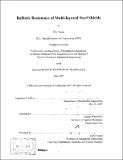| dc.contributor.advisor | Tomasz Wierzbicki. | en_US |
| dc.contributor.author | Huang, Min, S.M. Massachusetts Institute of Technology | en_US |
| dc.contributor.other | Massachusetts Institute of Technology. Dept. of Mechanical Engineering. | en_US |
| dc.date.accessioned | 2008-01-10T15:50:30Z | |
| dc.date.available | 2008-01-10T15:50:30Z | |
| dc.date.copyright | 2007 | en_US |
| dc.date.issued | 2007 | en_US |
| dc.identifier.uri | http://hdl.handle.net/1721.1/39878 | |
| dc.description | Thesis (S.M.)--Massachusetts Institute of Technology, Dept. of Mechanical Engineering, 2007. | en_US |
| dc.description | Includes bibliographical references (p. 135-137). | en_US |
| dc.description.abstract | In this thesis, the ballistic resistance of multi-layered steel shields against projectile impact at the sub-ordnance velocity is evaluated using finite element simulations. Eight types of projectiles of different weight and nose shapes are considered, while the multi-layered shields studied are the double-layered shield with the plates initially in contact, the double-layered shield with the plates spaced, the double-layered shield with the plates welded together and the BRAS shield. According to our simulation results, the double-layered shields are able to improve the ballistic limit by 7.0% - 25.0% under the impact of the flat-nose projectile, compared to the monolithic plate of the same weight. Under the impact of the conical-nose projectile, the double-layered shields are almost as capable as the monolithic plates. For the double-layered shields with different material combinations, the best configuration is that with the upper layer of high ductility material and the lower layer of low ductility material under moderate detrimental impact. The configuration results in some 25% gain in the ballistic limit. | en_US |
| dc.description.abstract | (cont.) The worst configuration is that with the upper layer of low ductility material and the lower layer of high ductility material. The BRAS shield, which has been shown to resist blast loading is proved to be equal to the monolithic plate in perforation resistance against the flat-nose projectile. This research helps resolve the long outstanding issue of the ballistic resistance of the multi-layered configurations. | en_US |
| dc.description.statementofresponsibility | by Min Huang. | en_US |
| dc.format.extent | 166 p. | en_US |
| dc.language.iso | eng | en_US |
| dc.publisher | Massachusetts Institute of Technology | en_US |
| dc.rights | M.I.T. theses are protected by copyright. They may be viewed from this source for any purpose, but reproduction or distribution in any format is prohibited without written permission. See provided URL for inquiries about permission. | en_US |
| dc.rights.uri | http://dspace.mit.edu/handle/1721.1/7582 | |
| dc.subject | Mechanical Engineering. | en_US |
| dc.title | Ballistic resistance of multi-layered steel shields | en_US |
| dc.type | Thesis | en_US |
| dc.description.degree | S.M. | en_US |
| dc.contributor.department | Massachusetts Institute of Technology. Department of Mechanical Engineering | |
| dc.identifier.oclc | 181656290 | en_US |
